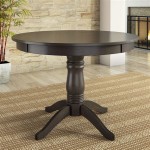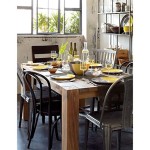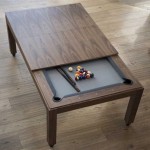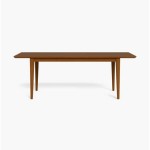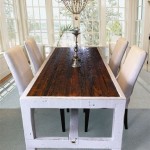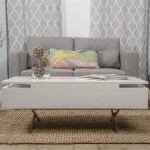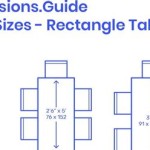```html
48 X 72 Dining Table: A Guide to Size, Style, and Functionality
A 48 x 72 dining table, measuring 48 inches wide and 72 inches long, represents a versatile and frequently sought-after size for dining spaces. This particular table dimension provides ample surface area for seating multiple individuals comfortably, accommodating both everyday family meals and larger gatherings. The size also allows for the placement of serving dishes, decorative centerpieces, and essential dining accessories without overcrowding the table.
The primary consideration when selecting a dining table of this size centers around the available dining room space. A room that is too small will make the table feel cramped, restricting movement and impacting overall comfort. Conversely, if the room is too large, the table may appear disproportionately small, potentially affecting the room's aesthetic balance. Before purchasing, meticulous measurement of the dining area is paramount to ensure the 48 x 72 table fits appropriately, leaving adequate space for chairs to be pulled out and for individuals to navigate around the table with ease. A general guideline suggests leaving at least 36 inches of clearance around the table for comfortable maneuverability.
Beyond spatial considerations, the design and style of the 48 x 72 dining table play a significant role in complementing the overall décor of the dining space. The available options are diverse, ranging from classic and traditional designs to modern and contemporary styles. The choice of materials further contributes to the aesthetic appeal and durability of the table. Solid wood tables, such as oak, maple, or walnut, are known for their robustness and natural beauty, often developing a richer patina over time. Veneer tables, which consist of a thin layer of real wood adhered to a less expensive core material, offer a cost-effective alternative while still providing a similar aesthetic. Other materials, such as glass, metal, and laminate, provide distinct visual appeal and varying levels of durability and maintenance requirements.
Key Considerations for Determining Table Size
Determining the appropriate table size for a given space requires careful evaluation of several factors. The most fundamental aspect is the number of individuals who will typically be seated at the table. While a 48 x 72 table can comfortably accommodate six to eight individuals, this depends on the width of the chairs and the desired personal space per diner. In instances where larger gatherings are common, an extendable table may be considered, allowing for increased seating capacity when needed. The shape of the table also contributes to the seating arrangement. Rectangular tables, like the 48 x 72, maximize seating along the length of the table, while round or oval tables encourage conversation and may save space in smaller rooms.
Another critical aspect is the overall layout of the dining room and the placement of other furniture pieces. Buffets, sideboards, and china cabinets can significantly impact the available space surrounding the dining table. The table's proximity to walls, doorways, and traffic flow patterns must also be considered to ensure ease of movement and prevent obstructions. Careful planning of the room's layout can help to optimize the use of space and ensure that the dining table is both functional and visually appealing. Consider the placement of lighting fixtures as well. Ideally, a chandelier or pendant light should be centered above the table to provide adequate illumination.
Finally, the existing décor and architectural style of the room should inform the choice of table size and shape. In a formal dining room with traditional furnishings, a larger, more ornate table may be appropriate. Conversely, in a smaller, more casual space, a smaller, simpler table may be a better fit. The table's dimensions should complement the scale and proportions of the room, creating a harmonious and balanced aesthetic.
Exploring Materials and Styles for a 48 X 72 Dining Table
The selection of materials and styles for a 48 x 72 dining table significantly influences both its aesthetic appeal and its durability. Solid wood tables offer a timeless elegance and exceptional longevity. Different wood species possess unique grain patterns, colors, and levels of hardness. Oak, known for its strength and durability, is a popular choice for traditional and farmhouse-style tables. Maple, with its smooth grain and light color, is well-suited for modern and contemporary designs. Walnut, prized for its rich, dark color and striking grain patterns, adds a touch of sophistication to any dining room.
Veneer tables provide a more cost-effective alternative to solid wood, while still offering the visual appeal of real wood. The quality of the veneer and the underlying core material are crucial factors to consider. High-quality veneers are durable and resistant to scratches and dents, while a sturdy core material ensures the table's stability. Metal tables, often featuring sleek lines and minimalist designs, offer a modern and industrial aesthetic. These tables are typically durable and easy to maintain, but may not provide the same warmth and character as wood tables. Glass-top tables create a sense of openness and transparency, making them suitable for smaller dining rooms. However, glass can be prone to scratches and requires regular cleaning.
Styles range from traditional to contemporary and everything in between. Traditional styles often incorporate ornate carvings, intricate details, and rich finishes. Contemporary styles emphasize clean lines, minimalist designs, and neutral colors. Farmhouse-style tables feature rustic details, distressed finishes, and a sense of warmth and informality. Choosing a style that complements the existing décor and personal preferences is essential for creating a cohesive and inviting dining space. Consider the table's leg style as well. Options include straight legs, tapered legs, pedestal bases, and trestle bases, each contributing to the overall aesthetic and stability of the table.
Optimizing Functionality and Seating Arrangements
Beyond aesthetics, the functionality of a 48 x 72 dining table is paramount. The height of the table is a crucial factor, typically ranging from 28 to 30 inches. This height is designed to accommodate standard-size dining chairs comfortably. The chairs themselves should also be carefully selected to ensure proper ergonomics and adequate legroom. The height of the chair seat should be approximately 12 inches below the table's surface, allowing for comfortable seating and ease of movement.
Seating arrangements can be optimized based on the shape of the table and the number of individuals to be accommodated. For a 48 x 72 rectangular table, placing chairs along the longer sides is the most common and efficient arrangement. Two chairs can be placed at each end of the table, or one larger chair can be positioned at each end for a more formal setting. The spacing between chairs should be sufficient to prevent crowding and allow for comfortable dining. Consider the width of the chairs when determining the optimal spacing. Bench seating can also be used on one or both sides of the table, providing a more casual and flexible seating option.
Furthermore, incorporating extendable leaves can significantly enhance the functionality of a 48 x 72 dining table. Extendable leaves allow the table to be expanded quickly and easily to accommodate larger gatherings. When not in use, the leaves can be stored separately, minimizing the table's footprint. This feature is particularly useful for individuals who frequently entertain guests but do not require a large table on a daily basis. The mechanism for extending the table should be smooth and reliable, ensuring ease of use. The leaves should also match the table's style and finish seamlessly, maintaining a cohesive and aesthetically pleasing appearance.
In summary, a 48 x 72 dining table offers a balanced combination of size and functionality for a wide range of dining spaces. Careful consideration of space, style, materials, and seating arrangements is crucial for selecting a table that meets both aesthetic and practical needs.
```
48 X 72 Frontier Shaker Dining Table W 10 Leaves

Luxcraft 48 X 72 Rectangular Dining Table

Mavin Customizable 48 X 72 Oval Dining Table The Cleveland Furniture Parma Mentor Brooklyn Twinsburg Brunswick Oh

Luxcraft 48 X 72 Rectangular Dining Table P46rtd

Luxcraft 48 X 72 Rectangular Dining Table

48 X 72 Amish Mission Standard Table W 4 Leaves

Trex Outdoor Furniture Parsons 38 X 72 Dining Table In Stepping Stone

Simply Amish Nblo4872 S Loft Ii Oval Table 48 X 72 W Solid Top Hickory Park Furniture

Luxcraft 48 X 72 Oval Dining Table P46otd

Country Viev Woodworking Mayan Collection Dining Table 48 Thomas Seaston Interiors

